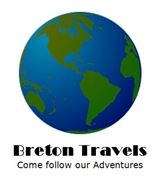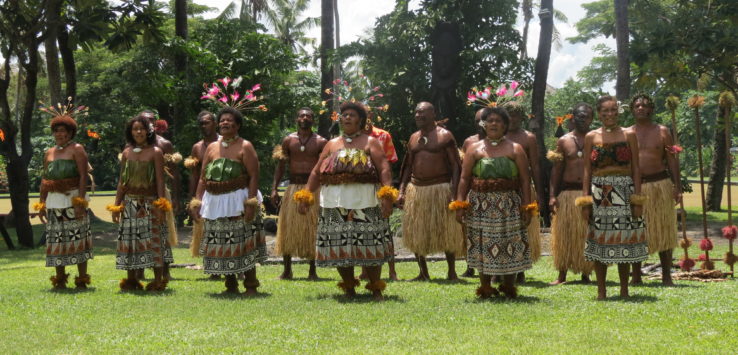We left the ship at 9:00am and boarded our bus. When boarding the bus, our
tour guide was the same tour guide from yesterday in Suva, Steve. He has such a great personality and very informative. During our 40 minute ride Steve covered all the things we learned yesterday, however I miss quoted what thank you is in Fiji. So here is a rundown of the correct phrases.
Hello – Bula
Yes – Io
No – Sega
Please – Kere Kere
Thank you – Vinaka
Good Bye – Moce (pronounced moh-thay)
The official currency is Fiji dollar.
Also during our bus ride, Steve explained to us the agenda for our tour. In addition to the fire walking ceremony, there will be a Kava ceremony and a walking tour of the Westin Resort property. Like yesterday, part of the Kava ceremony there needs to be a Chief for our group. No one volunteered, so I raised my hand. The Kava ceremony we observed yesterday was interesting, so I have no doubt that one will be just as great. Cindy and I did notice that the area was more
developed than Suva. I believe the development maybe because the international airport is in the area and many of the resorts are close by. One observation I noticed when driving to the hotel is that the mountains were really beautiful and very rugged looking. Much more than in Suva. There was also a ton of Sugar Cane growing everywhere.
We arrived at the Westin Resort and had to enter through a security gate. The entrance to the resort area is very similar to Costa Rica, you enter through a security gate and then there are several resorts and homes in the area. The Westin Resort entrance was so beautiful and very tropical. Something I would envision here in Fiji. Our bus dropped us off in the valet area and we proceeded to the show area. Prior to settling down in the entertainment area, I took photos of the hotel lobby and the awesome pools that cascaded towards to the ocean.
Cindy and I found seats in the front row, however still in the shade. It was super-hot today, mid-upper 80’s and very high humidity. We felt like we are back in Houston. Cindy and
I noticed that in the middle of the performance area there was a fire pit where they were heating up the stones that they would walk across. There was not a high flame, however a seaming pile of wood. Once the other bus arrived, the show began. A couple of the performers came out; one should the audience how to break open a coconut (pounded the coconut on a sharp object) and then shaving the coconut using a tool he put between his legs. Once he had shaved enough coconut some of the audience was able to come up and taste it. Cindy is a huge coconut lover, so she tasted it. Cindy mentioned that there was no real favor to the coconut. I mentioned to her that I wonder if the coconut she is used to is processed and enhanced. The other activity that was going on during the coconut demonstration was a performer that was converting coconut tree palms into a basket. It took him about 10 minutes to create the basket. He gave the finished product to a lady that was taking pictures.
Following this, the Kava ceremony started. This one was setup a
little differently, I am thinking because the area was so large and the sun was really hot. They prepared the Kava in a sack and squeezed out the Kava room juices after it was submerged in water. Since I was the chief our tour group I presented with the first bowl of Kava. I really wanted a low tide (small amount), however he gave me a Tsunami (very large amount). I had to drink the entire, I was not allowed to sip or stop. I was a trooper and consumed the Kava all at once. Today, my tongue and lips were a numb, most more than yesterday. Cindy also tried Kava again; she did not really feel the effects, just like yesterday.
The main show started with all the performers coming out slowly and the narrator of the show explained all their roles. The roles included a religious leader, chief, fire walkers, etc. the performers were very ceremonious as it relates to preparing the fire walking ceremony. The removed the large rocks with a command from the leaders. To remove the logs, they used thick vines to lift off and carry the logs away from the fire.
During the removing the logs off the fire, there were large yells from the performers. Once all the logs were removed from the fire, they used large spears to move the hot rocks around in the fire, securing them so the walkers could cross the fire safely. Once the rocks were positioned correctly, the ceremony continued with the fire walking. The first person to cross the rocks was the religious leader, then the tribe chief crossed, finally the other crossed the fire, walking on hot rocks. From what I could observe from a distance is that the performers walked on their heels. This makes sense since there is so much callus on the heal.
Following the fire walking ceremony, the performers came out performed traditional Fiji dances, some were the same and others were different from the prior day. This was quite entertaining. I took a ton of videos that I will probably post on You Tube later. Each of the Fiji dances were accompanied by a narrator explaining the different dances and what they meant. Apparently the chief of the tribe has 10 wife’s, interesting.
Following the beautiful performance, we had the opportunity
to snacks on fresh fruits and pastry’s. Cindy and I passed on the fruits since we heard the water supply is not healthy. We were not sure if the hotel had filtered water. We did eat however the pastry’s, they were good. Our snack time lasted about 30 minutes, and then move along to tour the resort by foot. This resort is beautiful. It is beautifully situated on the ocean with lots of pool area and outdoor sitting and dining. One thing that Cindy and I noticed was there were no sand beaches, rather large rocks instead on the beach. We asked Steve whether the other resorts had sand beaches, he said the only hotel having sand beach is the Hotel Sofitel. Prior to this observation, I was actually mulling over whether this would a great location to back and visit, without the sand beaches, maybe not.
After our beautiful walking tour of the hotel property, we boarded our bus to starting back to the ship. Prior to arriving at the ship, we stopped at a shop. For the 30 minutes we shopped, we were able to purchase a few items and then access their free Wifi.
Here is a briefly introduction to Lautoka, Fiji. (source Wiki)
Lautoka is the second largest city of Fiji. It is in the west of the island of Viti Levu, 24 kilometres north
of Nadi, and is the second port of entry in Fiji, after Suva. Lying in the heart of Fiji’s sugar cane growing region, it is known as the Sugar City. Covering an area of 16 square kilometres, it had a population of 52,220 at the 2007 census, the most recent to date.
Lautoka is known as the Sugar City because of its sugar cane belt areas. The main Lautoka Sugar Mill is the city’s biggest employer by far. Built for the Colonial Sugar Refining Company (Fiji) (CSR) by workers from India and the Solomon Islands between 1899 and 1903, it hires some 1,300 employees today. Other industries include timber milling, garment manufacturing, distillery, brewery, jewelry, blending, steelworks, fishing, hatchery, domestic items, paints, and construction. In 2012 Lautoka was announced as the administration capital of the western division..
The name of the city is derived from two Fijian words meaning “spear hit.” According to an oral tradition, the name arose following a duel between two chiefs. As one speared the other, he was reported to have cried “Lau-toka!” The first known European sighting of the Lautoka area took place on 7 May 1789. Captain William Bligh spotted and roughly charted the coasts of Lautoka
while making his epic voyage to Timor, in the wake of the Mutiny on the ”Bounty” in which he and a few sailors loyal to him were thrown overboard and cast adrift on a life boat.
Ratilal Patel was a mayor in 1967. Incorporated as a town in 1929, Lautoka was proclaimed a city on 25 February 1977. It is governed by a 16-member city council, who elect from among themselves a Mayor. Lautoka currently does not have a mayor but has a government appointed mayor like all urban centres in Fiji since the military coup of 2006 the current administrator is praveen Bala who is a former mayor of ba 4. Lautoka is the only city in Fiji’s Western Division, and is the industrial hub of Fiji which contains more than 50 percent of the nation’s population. It is also the headquarters of the Fiji Electricity Authority, the Fiji Pine Ltd, and the National Marketing Authority.
The headquarters and studios of Mix FM Fiji are located in Lautoka. With National coverage, MixFM is the only English station in Fiji to be based outside of Suva.
Since 1970, the population of Lautoka has grown rapidly, and in the last twenty years it has also
changed dramatically in structure. In the early 1970s the population was estimated to be about 12,000, the vast majority of inhabitants being Indian, as would be expected considering the early growth of the city was entirely associated with the sugar industry. Almost all of the present Indian inhabitants are descendants of the early girmityas. In 1986 the population was 39,000 and in 1996 almost 43,000, but it is not clear exactly how the boundaries of the urban area were defined at either of these censuses. In 2005 the population including the suburban zones was probably about 50,000, occupying a total area of about 16 km². The population of Lautoka including the rural districts is around 80,000. But much of the recent growth of the city itself has been due to indigenous Fijians moving into the urban area.
The city is the birthplace of PGA Tour Hall of Famer Vijay Singh and Ghazal and Tabla star Cassius Khan.















